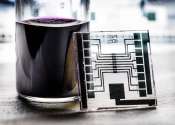Thick-film conductive ink suitable for large-area, large-current printed electronics
A thick-film, electrically conductive ink suitable for printing electronic circuits and sensors on the surfaces of films and other substrates to manufacture printed electronics has been jointly developed by NIMS, Sumitomo ...
Feb 27, 2024
0
2









